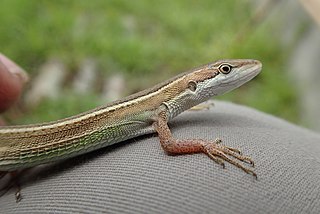
Takydromus is a genus of lizards, commonly called grass lizards or oriental racers. Species of the genus Takydromus are endemic to a large part of Asia. Members of this genus are noticeable because of their slender appearance and their agile movements. The word takydromus derives from Greek ταχυδρόμος (takhudromos), "fast-running", from ταχύς (takhus), "swift" + δρόμος (dromos), "course, race".
Takydromus haughtonianus, commonly known as the Goalpara grass lizard, is a species of lizard in the family Lacertidae. The species is endemic to India.

Takydromus khasiensis is a species of lizard. It is found in Northeast India, adjacent Myanmar (=Burma), and northern part of Bangladesh. The type locality is the Khasi Hills.

Takydromus sexlineatus, the Asian grass lizard, six-striped long-tailed grass lizard, or long-tailed grass lizard, is an arboreal, diurnal species of lizard. The tail length is usually over three times the body length in this species.

Takydromus tachydromoides, the Japanese grass lizard, is a wall lizard species of the genus Takydromus. It is found in Japan. Its Japanese name is 'kanahebi' (カナヘビ). 'Hebi' means 'snake' in Japanese, although this lizard is not a snake. There are three species of lizards found on the four main islands of Japan. The other two are the Japanese gekko and the Okada's Five-lined Skink.

Oncorhynchus masou formosanus, commonly known as the Formosan salmon, Taiwanese trout, Tsugitaka trout, Lishan trout or Slamaw trout, is an endangered freshwater fish endemic to the mountain stream valleys between the Xueshan and Central Ranges of Taiwan. It is the southernmost subspecies of masu salmon, and one of the most temperately distributed salmonids along with the Mexican golden trout and Mexican rainbow trout.
The large-scale grass lizard, also known as the large-scaled snake lizard, Zambian grass lizard, or Zambian snake lizard, is a species of lizard in the genus Chamaesaura. It lives scattered across southern Africa with two subspecies.
Takydromus toyamai, also known commonly as the Miyako grass lizard, is a species of lizard in the family Lacertidae. The species is endemic to the Ryukyu Islands.

Achalinus formosanus, common name Formosan odd-scaled snake or Taiwan burrowing snake, is a non-venomous snake in family Xenodermidae that is found in Taiwan and in the southern Ryukyu Islands (Japan).

Diploderma swinhonis, also known commonly as the Taiwan japalure, Swinhoe's japalure, Swinhoe's lizard, and Swinhoe's tree lizard, is a species of lizard in the family Agamidae. The species is native to Taiwan. It is considered an invasive alien species in Japan after likely being transported from Taiwan by humans. A foraging ambush predator, this lizard preys primarily on arthropods and thus remains at the bottom of forests perched on trees where sunlight is present. D. swinhonis is not a major threat to humans and is able to adapt to a variety of habitats, including urban environments. The male D. swinhonis is physically distinct from the female, with its body size being much larger and having a yellow stripe. This species sexually reproduces on a seasonal basis and hibernates during the winter time.
The short-legged japalure is a species of lizard endemic to Taiwan. It is found in mountains at elevations of 1100 to 2200 m and inhabits forest edges. It has a 10-cm long body, and the total length reaches 25 cm. It is sexually dimorphic. The male has a black back, with yellow-green spots and stripes. The female is mainly green. A diurnal and oviparous species, it eats insects and other small invertebrates. The species was described by J. Linsley Gressitt in 1936. It is listed as other conservation-deserving wildlife in the Taiwan Wildlife Conservation Act. This lizard is closely related to Diploderma swinhonis

Takydromus dorsalis, the Sakishima grass lizard, is a species of lizard in the family Lacertidae. It is endemic to the Yaeyama Islands in southern Japan.
Takydromus hani, also known commonly as the green grass lizard, the southeast Asian green grass lizard, and the Vietnamese green grass lizard, is a species of lizard in the family Lacertidae. The species is endemic to Vietnam.

Takydromus sauteri, known commonly as the Koshun grass lizard, is a species of lizard in the family Lacertidae. The species is endemic to Orchid Island in Taiwan.

Takydromus stejnegeri is a species of lizard in the family Lacertidae. The species is endemic to Taiwan.
Shuanglianpi Wetland is a partially protected natural area in Yilan County in northern Taiwan. Situated 470 meters above sea-level, it contains a botanically rich, shallow lake, which, from the perspective of plant species density, is considered to be a wetland with global significance by the Forestry Bureau of Taiwan.









